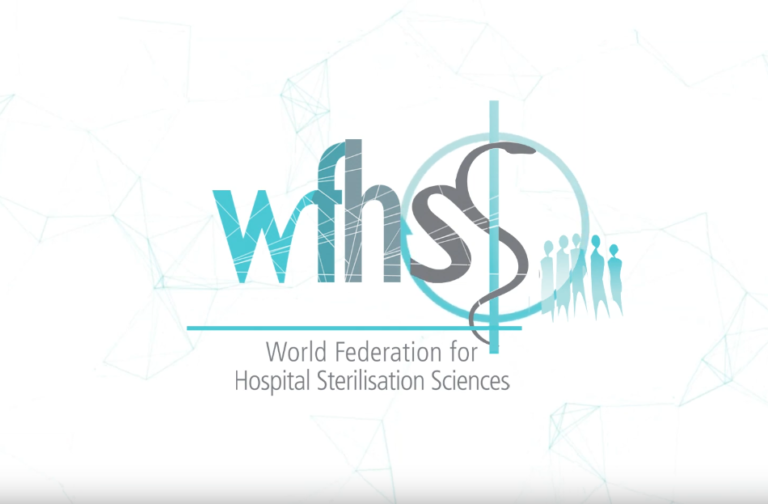Packaging is intended to preserve the sterility of the reusable medical devices (RMD) until its use. To meet this objective, the packaging system:
Precautions must be taken to protect fragile parts of a RMD and avoid breach of the microbial barrier. For instance, sharp edges of RMD are shielded, and RMD are methodically installed in a basket, tray or instrument organizers. |
- Is compatible with the sterilization process.
Compatibility concerns all packaging components installed before sterilization, means :
|
- Alllows aseptic presentation of the RMD
Aseptic presentation is defined by international standard ISO 11607-1 as:
"Transfer of sterile contents from its sterile barrier system using conditions and procedures that minimize the risk of microbial contamination".
To minimize risks during aseptic presentation:
|
![]() International standard ISO 11607-11,2 defines packaging functions as follows :
International standard ISO 11607-11,2 defines packaging functions as follows :
The Sterile Barrier System (SBS) is “the minimum package that minimizes the ingress of microorganism and allows aseptic presentation of the sterile contents at the point of use”.
The protective packaging (PP) is “the configuration of materials designed to prevent damage to the sterile barrier system and its contents from the time of their assembly until the point of use”.
The packaging system (PS) is “the combination of a sterile barrier system and protective packaging”. s
Sterile barriers technologies available on the market are as follows;
- Single use wraps are made of woven or nonwoven cellulose, synthetic or mixed cellulose/synthetic sheets. Wraps are commonly used for baskets and instrument sets. Wraps manufacturers define the number of wrap layers required for compliance to resistance and microbial barrier criteria defined by international standards. Wraps layers may be independent (sequential) or pre-bonded.
Various folding methods are used (e.g., envelope, square or parcel or parallel, roll or pasteur). Name or preference for methods, may vary according to regions, habits or both. Folding is secured by adhesive tapes which usually serve also as sterilization indicators. Training of operators in charge of folding is key. Tutorials are available in different languages.
- Single use pouches or reels are made of 2 sheets pre-sealed on 3 sides (pouches) or 2 sides (reels).
Pouches and reels are available in various dimensions and strengths. Rolls of reels are cut at the desired length.
At least, one side of the pouch or reel is permeable to the sterilizing agent. The permeable side is made of nonwoven cellulose, synthetic or mixed cellulose/synthetic material. The other side is a transparent film (usually not permeable to the sterilizing agent).
Pouches and reels are commonly used for light weight instruments or trays.
Closure of pouches or reel is preferably by heat sealing. By default, when heat sealing equipment is not available, pouches with self-sealing adhesive can be used.
| Heatsealers are calibrated at temperature and pressure as defined by a pouch manufacturer. Minimum strength and minimum width of seals are defined by international standards. Maximum strength must be defined such that aseptic presentation is not compromised. An arrow (chevron) indicate peel direction. RMD handles are on the opening side to ease extraction. Sharp edges are on the opposite side to avoid injuries. 75% of an internal surface (within seal limits) remains free to allow the packaging to absorb pressure variations. Before sealing, air is forced from the pouch to avoid bulging. Sealing is at a minimum distance of 3 cm of pouch side to make opening easier. Integrity and continuity of the sealing is visually controlled . Seal integrity tests are available on the market to periodically check that thermosealers are correctly used and calibrated (using, for example, the ink test). |
- Reusable containers (box and lid) are made of aluminum, stainless steel or high-density polymers. Containers are available in various standardized sizes and often used with multiple basket or set compositions. A sterilizing agent penetrates through a filter, single use (most frequent) or reusable. Cleaning and disinfection of containers is as defined by the container’s manufacturer IFU, and requires organization, supplies and equipment. Maintenance plans are in place.
Before reprocessing, disposable items are discarded, and reusable accessories are disassembled. Container gaskets, mating surfaces, and latching mechanisms are visually inspected very carefully for cleanliness, distortion, impact, defect (which could impair the sealing), filtering, and locking functions. Dirty containers are cleaned again. Damaged containers are sent for repair.
Many manufacturers recommend single use filters. Reusable filters are inspected and discarded if defective. If manufacturers specify a maximum number of reprocessing cycles, the filters are discarded when this number is reached.
- Reusable textiles are made of cotton or polyester. Like single use wraps, they are mainly used for basket and instrument sets.
Barrier performances of traditional cotton wraps are poor and deteriorate by repeated laundering and sterilization. Visual inspection for holes, and tears, are at risk for human error, which is not reliable. Textile release particles which may pollute a RMD or spread in the sterile area during extraction.
Polyester reusable wraps have better initial barrier performance than cotton. Evidence must be provided by the manufacturer that the sterile barrier performance remains satisfactory over the allowed number of reuses. Means must be provided to control the number of reuses. Controls should be performed by trained personnel in conditions that minimize the risks of errors.
SBS and SBS material performance must conform to international standards. Except for cotton textile, international standards define performances of SBS materials.
![]() International standards ISO 11607-1 and -2 describe criteria and methods to test the packaging design, material and closure (e.g., resistance, permeability to air, biocompatibility, and aging, etc..). For several criteria, different methods may be proposed. For instance, there is no unique universally accepted test for sterile barrier performances. A manufacturer may use one or several methods and test internally, or preferably with support of external independent laboratories. At least one method that uses a pass or fail criteria should be utilized.
International standards ISO 11607-1 and -2 describe criteria and methods to test the packaging design, material and closure (e.g., resistance, permeability to air, biocompatibility, and aging, etc..). For several criteria, different methods may be proposed. For instance, there is no unique universally accepted test for sterile barrier performances. A manufacturer may use one or several methods and test internally, or preferably with support of external independent laboratories. At least one method that uses a pass or fail criteria should be utilized.
There is no unique way to adequately package a given RMD or RMD composition. A packaging process is defined in partnership with surgical or medical users. A packaging process is adapted to the organization of the sterilization department and healthcare facility. Local recommendations or regulations may be applicable.
For each packaging configuration, a risk analysis should address the following hazards and hazardous situations:
- The conformity with the packaging manufacturer’s IFU and international standards
- The compatibility with the sterilization process (pressure changes, temperature, chemical impact)
- The worst case scenarios regarding transport and storage conditions and their potential impact on the SBS and RMD.
- The achievement of aseptic presentation objectives
- Expiration date determination. Expiration dates are event-related (i.e. related to transport and storage risks). Expiry dates are always more pessimistic than aging tests performed by packaging manufacturers.
Multiple layers of SBS are commonly used (double pouch or reel, double-wrapping or wrap in a container). Risk analysis should confirm the need for multiple layers in an SBS. In any case, it must be checked that:
- Multiple layers in an SBS are compatible with the sterilization process
- For pouch and reels : space left around an internal SBS is sufficient. Criteria for space around an internal SBS are the same as for an RMD. Internal pouches or reels are not folded to fit into an external SBS. Internal seals are not crossed by sealing of an external SBS
- For wraps: that double wrapping is not an incentive to minimize attention paid to folding
- Multiple SBS’s does not increase extraction risks.
Packaging takes place in a controlled environment. The space allocated to packaging operations is separated from the cleaning area. Air quality is determined by local regulations or best practices.
There is no unique way to correctly package a given RMD. A packaging process is defined in partnership with a surgical or medical user, according to RMD characteristics, organization, and experience of the sterilization department. For example, a general hospital with an internal sterilization department will not have the same imperative as a specialized surgery center with outsourced reprocessing. Local recommendations or regulations may apply.
Written SOP’s describe each step of the packaging process. SOP’s include RMD and packaging manufacturers’ IFU’s.
- Expiration dates (for single use packages) or maximum number of reuse (for reusable containers) are checked. Expired wraps, pouches or reels are discarded according to waste management procedures, and/or manufacturers’ IFU’s, local regulations, or all three entities.
- Packaging is visually controlled.
Wraps, pouches and reels are controlled for integrity(i.e. by detecting holes or pinches). Damaged items are discarded according to manufacturers’ IFU’s and local regulations.
Container gaskets, mating surfaces, and latching mechanisms are inspected for cleanliness, distortion, impact, defect (which could impair the sealing), filtering or locking functions. Dirty containers are re-cleaned. Damaged containers are sent for repair. Reusable filters are inspected and discarded if defective.
- Before insertion in an SBS, RMD’s are, as needed, equipped with protection accessories, and installed in a basket, tray or organizers. Protection and organizers ease aseptic presentation and limit the risk of operators injuries. For pouches and reels, handles are on opening side, and sharp edges are on the opposite side.
In trays, instruments with concave surfaces are positioned on their side to ease diffusion of the sterilizing agent, and allow for moisture to collect in the concave portion to drain (for moist heat sterilization)
- SBS’s are hermetically closed. A container lid is fastened with temper-evident indicators. Wraps are folded. Pouches and reels are sealed. If required per the risk analysis, additional layers of pouch, reel or wrap are implemented with similar precautions.
- An SBS carries individual labeling. Labels are visible (i.e. on an external wrap, in case of double wrap). If a protective package (PP) contains several SBS’s, means are provided to identify the SBS enclosed in the PP. For pouches and reels, a label is placed on the non-permeable side. Writing or printing on the porous web is not allowed, as ink could seep through the packaging. Conversely, writing or printing on the porous web which does not come in direct contact with the medical device is allowed. Each container carries a traceability tag. Labels are compatible with the sterilization process. Expiration dates are defined according to SOP’s.
- After sterilization, each item is visually controlled. Damages, non-conformities and missing or incomplete labels are reported and analyzed. Visible damage on an external pouch, reel or wrap is an incentive to check damages of the internal SBS. As needed, RMD’s are repackaged and sterilized or cleaned and sterilized. A root cause analysis should be performed and the risk control measures should be adapted accordingly.
- As needed, protective packaging (post sterilization) is implemented. If a protective packaging includes several SBS’s, contents of the protective packaging is visibly indicated.
Written packaging standard operating procedures (SOP) are prepared in accordance with Quality Management principles.
A SOP is available for each group of RMD’s sharing a common packaging process (i.e. same sterilization procedure, same type of SBS, protective measures for transport and storage). Each SOP is based on a thorough step-by-step risk analysis from package preparation to aseptic presentation. A risk analysis is challenged by a real life test in worst case conditions for each type of representative packaging.
Packaging process validation controls:
- The packaging area of the sterilization facilities is adequately designed and installed (e.g. including lighting, packaging workstation etc.) and that air quality is appropriate and monitored.
- Sealing equipment is properly installed and calibrated.
- Manufacturer’s instructions for use (IFU) for SBS and heat sealing equipments are available.
- Packaging Certificates of compliance with international standards and certificates of tests performed to claim compliance are provided.
- SOP’s are up to date
- Occupational health and safety considerations are included. Packaging facilities and workstations are adequately designed, installed and equipped; precautions are taken against injuries by sharp RMD’s or excessive loads. The maximum total weight of a packaged items does not exceed 10 kg (including the container, if that type of reusable SBS is used)
- Training is executed and certificates are available.
| All operators involved in packaging preparation, transport, storage and extraction receive appropriate training. A packaging process, involves many manual or semi-manual operations, and correct execution of these operation is critical. No protection is enough against improper handling during transport or storage. Finally, all efforts to bring a sterile RMD to the point of use (i.e., operating theater) are ruined if aseptic presentation is not done with care. |
- Maintenance plans are in place for reusable containers and sealing equipments
- Systematic and periodic routine controls are defined for all type of SBS.
- Traceability is operational
Validation is repeated each year or after a change that justifies a partial or total revalidation . Procedure and training are updated as needed.

WFHSS key recommendations for packaging
- The packaging process is key for efficient sterilization and preservation of sterility until use of an RMD. A risk analysis checks that all packaging configurations:
- Meet sterile barrier criteria
- are compatible with the sterilization process
- adequately preserve the SBS and its contents against worst case transport and storage events
- achieve aseptic presentation objectives.
- Packaging process validation checks that
- SBS IFU, and certificates of compliance to international standards are available. When there is no unique standardized test method for a given criteria (e.g., microbial barrier), methods using a clear pass and fail threshold are preferred. Tests performed by independent test laboratories are preferred to internal testing by a manufacturer. Non-compliant SBS’s and, in particular, cotton textiles are not used.
- Packaging equipments and workstations are adequately designed, installed and maintained.
- SOP’s are up to date
- That expiration dates are event related
- All operators involved in the packaging chain, including logistic and point of use staff, receive adequate training and are conscious of their contribution to the delivery of safe and functional RMD’s and patient safety.

RMD ready to be packaged in preparation for sterilization
Go to objectives of packaging →
1 of 12 Sterillized RMDRMD sterility preserved by SBS
Go to packaging process →
2 of 12 RMD in packaging systemRMD ready for transport and storage and aseptic extraction
Go to packaging process →
3 of 12 RMD in packaging systemPackaging system ready for transport and storage and extraction
Go to packaging process →
4 of 12 Reusable textilesReusable Cotton textile to be avoided
Go to choice of the packaging method →
Implementation according to SOP
Go to Packaging process →
5 of 12 Reusable containersContainers compliant to international std cleaned and disinfected and controlled
Go to choice of the packaging method →
Implementation according to SOP
Go to Packaging process →
6 of 12 Single use pouches or reelsPouches and reels compliant to international std
Validated sealing
Go to choice of the packaging method →
Implementation according to SOP
Go to Packaging process →
7 of 12 Single use wrapsWraps compliant to international std
Folding according to validated practices
Go to choice of the packaging method →
Implementation according to SOP
Go to Packaging process →
8 of 12According to SOP defined after risk analysis
Go to ![]() WFHSS recommendations for packaging →
WFHSS recommendations for packaging →
Visual controls
Go to Packaging and quality →
10 of 12Packaging compatible with sterilization process
Go to Objectives of packaging →
11 of 12As needed installation of protective packaging
Go to packaging process →
12 of 12- ISO 11607-1 : Packaging for terminally sterilized medical devices – Part 1: Requirements for materials, sterile barrier systems and packaging systems (2019)
- ISO 11607-2 : Packaging for terminally sterilized medical devices — Part 2: Validation requirements for forming, sealing and assembly processes (2019)
- ISO/NP TS 16775 : Packaging for terminally sterilized medical devices — Guidance on the application of ISO 11607-1 and ISO 11607-2
- EN 868 2 to 10 Packaging for terminally sterilized medical devices – Part 2 to 10.
- Decontamination and reprocessing of medical devices for health-care facilities – WHO (2016)
- ISO 17664 : Processing of health care products – Information to be provided by the medical device manufacturer for the processing of medical devices : 2017













